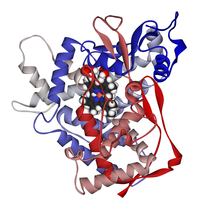
Photo from wikipedia
Arsenic is a metalloid that is highly toxic to living organisms in the environment. In this study, toxicity caused by inorganic arsenate (As(V)) to terrestrial plants, such as barley Hordeum… Click to show full abstract
Arsenic is a metalloid that is highly toxic to living organisms in the environment. In this study, toxicity caused by inorganic arsenate (As(V)) to terrestrial plants, such as barley Hordeum vulgare and wheat Triticum aestivum, was predicted using the existing biotic ligand model (BLM) for bioluminescent Aliivibrio fischeri via interspecies extrapolation. Concurrently, the concept of cell plasma membrane electrical potential (Ψ0) was incorporated into the extrapolated BLM to improve the model predictability in the presence of major cations such as Ca2+. The 50% effective As(V) toxicity (EC50{HAsO42−}) to H. vulgare decreased from 45.1 ± 4.34 to 15.0 ± 2.60 µM as Ca2+ concentration increased from 0.2 to 20 mM owing to the accumulation of H2AsO4− and HAsO42− on the cell membrane surface. The extrapolated BLM, which only considered inherent sensitivity, explained well the alteration of As(V) toxicity to H. vulgare and T. aestivum by Ca2+ with in an order of magnitude, when considering a linear relationship between Ψ0 and EC50{HAsO42−}.
Journal Title: Toxics
Year Published: 2022
Link to full text (if available)
Share on Social Media: Sign Up to like & get
recommendations!